
1
Microchip Pet Door
Instruction Manual

2
Contents
Important Notice 3
1. Box Contents 4
2. User Interface 5
3. Introduction 6
4. Microchip Type 7
5. The SureFlap RFID Collar Tag 7
6. Learn Mode 8
7. Installation 9
8. Batteries and Low Battery Indicator 19
9. Operation 20
10. Locking Modes 20
11. Curfew Mode 21
12. Memory Wipe 22
13. Use As A Non-Selective Pet door 22
14. Custom Modes 22
15. Maintenance 24
16. Troubleshooting 25
17. Warranty & Disclaimer 27

3
Important Notice
Please read all these instructions BEFORE tting the SureFlap Microchip Pet Door. Importantly,
please check whether there is metal in the substrate the door is to be tted into. Please follow the
metal mount instructions in section 7.4 if this is the case.
Under no circumstances should you cut or drill through the tunnel of the main
assembly of the unit as this contains the microchip reader and will prevent the
unit from working properly.
The SureFlap Microchip Pet Door operates with all 9, 10, and 15-digit microchips that are
commonly used for pet identication. Alternatively, you can use the pet door with the SureFlap
RFID Collar Tag (one included – packs of two sold separately), please see section 5 for more
information.
Every effort has been made to ensure that the SureFlap Microchip Pet Door operates with all
relevant microchips. However, there are a small number of circumstances relating to the position
of your pet’s microchip and the signal strength of the individual chip, which may mean that the
pet door does not operate reliably.
We therefore strongly advise that the following checks are carried out before permanent changes
are made to a door to install the pet door:
1. Insert batteries (for instructions see section 8) and leave for 10 seconds with nothing in the
tunnel so the sensors can settle.
2. Follow the learn process as in section 6, encouraging your pet to put its head up to the door in
order to learn the microchip’s number. Once a pet’s microchip number has been successfully
learnt, the ap reverts to normal operation and the LCD screen will stop ashing. Once your
pet moves away from the pet door the locks will close.
3. Finally, test the normal operation of the door. Again persuade your pet to put its head up to
the door from the tunnel side. Try to make sure this is similar to how your pet would use it in
practice, as shown below. The locks should open.
4. Repeat the learn process for each of your pets.

4
1. Box Contents
1. Main Door Assembly (inside house)
2. External Frame (outside house)
3. Battery Compartment (one on each side)
4. Battery Covers x 2
5. Button Cover
6. Buttons (see User Interface for more information)
7. LCD Screen (see User Interface for more information)
8. Indicator Light
9. Double Locking Mechanism
10. Draught Excluder
11. Selection of Screws
12. Screw Caps
13. Collar Tag
8
1
6
5
7
3
4
10
9
2
1211 13

5
2. User Interface
2.1 Buttons
1. Lock Mode Button
2. Time Set/Current Time Button
3. Lock Time Button
4. Unlock Time Button
5. Learn Button
Fn (Function) – See Custom Modes (section 14)
2.2 LCD Screen
1 2 3 4 5
Locking Mode In
Locking Mode Out
Time Display Battery Indicator
Microchip Reader
Enabled
Current Time
Lock Time
Unlock Time

6
3. Introduction
Congratulations on your purchase of the SureFlap Microchip Pet Door. This pet door has been
designed to recognise either the microchip already implanted in your pet or the SureFlap RFID
Collar Tag (one included – packs of two sold separately), allowing access to your pet whilst
keeping out intruder animals. Your home becomes a secure environment for your pet, leading to
a happier, more relaxed animal.
Operation of the SureFlap Microchip Pet Door couldn’t be simpler. Once the batteries have been
inserted, the door can be put into learn mode. The next pet to pass through the door from either
direction, or to put its head into the tunnel with its nose up to the door, will have its microchip
or collar tag number stored in the memory. Now the pet door is ready to install and will unlock
whenever your pet wants to come into the house.
Multiple pets are no problem. Up to 32 pets can be programmed into the pet door at the same
time – more than enough for most people’s needs!
The SureFlap Microchip Pet Door has all the features you would expect from a high quality pet
door, including:
• Robust and elegant design
• Learn mode for programming multiple pets
• Double lock mechanism
• Curfew mode: program the door to lock and unlock at specied times
• Low battery indicator
• Typical battery lifetime at least 6 months
1
We wish you years of trouble-free operation with your SureFlap Microchip Pet Door and hope
you enjoy the benets it brings to your home and pet.
1 Based on normal usage. Note that heavy usage by many cats may reduce battery lifetime.

7
4. Microchip Type
The SureFlap Microchip Pet Door is compatible with all microchips commonly used for pets.
Specically this includes:
• 15-digit microchips (also known as FDXB)
• 10-digit microchips (also known as FDXA and Trovan
®
Unique)
• 9-digit microchips (also known as Avid
®
Secure/Encrypted)
In addition to this the pet door is also compatible with the SureFlap RFID Collar Tag (one included
- packs of two sold separately).
Extensive tests have shown that the SureFlap Microchip Pet Door works perfectly with the vast
majority of microchips. However a very small percentage of pets have a microchip without the
required range for the pet door. In these rare cases please contact our customer service team
for further assistance.
If permanent changes to a door or wall are required for installation we strongly advise
testing the SureFlap Microchip Pet Door with your pet(s) rst. In order to test that it
works with your pet(s) please carry out both the learn process (see section 6) and then
test normal operation (see section 9).
5. The SureFlap RFID Collar Tag
We recommend microchipping over the use of collar mounted tags, as microchips are a
permanent form of identication that cannot become lost.
However, if your pet is not, or cannot, be microchipped and you choose to use the SureFlap RFID
Collar Tag, for cats you should always use a safety collar that has a breakaway buckle.
The SureFlap RFID Collar Tag is a small, lightweight tag that can be attached directly to your
pet’s collar. Like microchips, each collar tag has a unique code, to prevent any non-resident
pets, strays or wild animals from entering your home.
One collar tag is included in the box. Additional SureFlap RFID Collar Tags are available via the
SureFlap website or from SureFlap retail and veterinary stockists.

8
6. Learn Mode
To start operation, the SureFlap Microchip Pet Door needs to learn the unique ID code of your
pet’s microchip. This process is only required once for each pet, as the code is permanently
stored, even if the batteries are removed. Follow the simple step-by-step guide below to carry
out this process:
1. Remove the button cover. Press the learn button ( ) for around 1 second and release.
See Figure 1.
2. The locks will open, allowing a pet to pass through in either direction. A further indication that
the unit is in learn mode is the ashing of the icons on the LCD screen.
3. The next pet to pass through the ap from either direction, or to put its head into the tunnel
with its nose up to the door, will have its microchip number stored in the memory.
4. Once a pet’s microchip number has been successfully learnt, the pet door reverts to normal
operation and the LCD screen will stop ashing. Once your pet moves away from the pet
door the locks will close.
For multiple pets, repeat the process until all pets’ microchip numbers have been learnt. The
microchip numbers of up to 32 different pets can be stored in memory at once. Replace the
button cover when the learn process has been completed for each pet.
This method of learning is particularly convenient for uncooperative pets! Rather than having to
nd your pet and pass it through the ap, you can simply set it to learn mode and leave until it
next decides to go through or put its head up to the door of its own free will.
To cancel learn mode (e.g. after pressing the learn button accidentally) simply press the learn
button ( ) again for around 1 second and the unit will revert to normal operation.
In order to learn a pet’s microchip number, a sensor located in the tunnel must detect a
pet’s presence to trigger the microchip reader. Therefore it is important to ensure that
your pet either puts its head into the tunnel or passes through the ap. No amount of
waving your pet in front of the door will have an effect.
To learn the SureFlap RFID Collar Tag carry out steps one to three above. Hold the collar tag in
your hand and then place your hand inside the tunnel of the SureFlap Microchip Pet Door making
sure that you touch the door. The unique code of the collar tag will be stored in the memory after
a few seconds.
Figure 1

9
7. Installation
DIY installation may involve the use of power tools or cut glass. Safety equipment (gloves, eye
protection, etc.) should be used and if in doubt consult a professional to carry out the installation.
Suitable door types
Instructions are provided for installation in all door types, including wooden, plastic, glass, and
metal. Before installing in a door with unknown construction please check for a metal
plate in case a larger hole is required, as described in the metal door installation section.
If you can only be sure of the construction of the door by drilling a hole in it, make a trial
hole anywhere covered by the proposed hole for the SureFlap Microchip Pet Door.
Pet door positioning
The ideal height of the SureFlap Microchip Pet Door is such that the base of the tunnel is the
same height above the ground as your pet’s stomach. In practice however, mounting is normally
dictated by features in the door into which the unit will be installed. In these circumstances, it is
usual to mount the pet door as low as possible.
7.1 Electrical interference
The SureFlap Microchip Pet Door contains a sensitive radio receiver to pick up the
signal from your pet’s microchip or collar tag. In rare instances, excessive levels of
electrical interference can cause the range of the system to degrade. Avoid the following
situations:
• The SureFlap Microchip Pet Door should not be used in the vicinity of other microchip
readers or similar low frequency devices. These are particularly detrimental to performance
and may prevent normal operation.
• Avoid obvious sources of electrical noise such as faulty, ickering lights.
• Avoid trailing mains cables and DC mains adaptors very close to the SureFlap Microchip
Pet Door.
If you suspect electrical interference may be affecting the performance of your SureFlap Microchip
Pet Door please contact customer service for assistance.

10
7.2 Installation in wooden doors, plastic doors, or plasterboard walls
1. Place the external frame face down as in Figure 2. Attach a ball of Blu Tack (or similar
adhesive putty) in each of the four corners. These should allow you to stick the frame to
most doors.
2. Choose the position on the door at which you want to mount the pet door and stick the
frame to the door. To ensure that it is level we recommend you use a spirit level as shown
in Figure 3.
3. Run a sharpened pencil or pen around the inside edge of the frame where it would touch
the door and also mark the four screw holes. You need to make a legible line as this will be
used for cutting against.
4. Remove the frame from the door and check you have a solid line and dots where the screw
holes are, as in Figure 4. Using a drill with a 6mm (0.25”) diameter bit, drill the holes for the
screws. It is vital these holes are drilled straight to ensure the two halves of the pet door
connect properly.
5. Before you cut out the hole for the tunnel drill holes in all the corners large enough to allow
your jigsaw blade through, see gure 5. Cut out the tunnel hole with an electric jigsaw –
ensure you cut 2mm (0.078”) outside the line you have marked for the hole to allow enough
clearance for the tunnel, see Figure 6. Make sure that your jigsaw is sitting at on the door
at all times while cutting.
6. Clean off any loose debris, dust and dirt from the door before you install the SureFlap
Microchip Pet Door.
7. Mount the pet door in the hole with the main assembly (battery covers and LCD screen)
inside the house. See Figure 7.
8. Mount the external frame on the outside of the house. Depending on the thickness of the door,
the tunnel will protrude through the frame by differing amounts. Under no circumstances
should you cut or drill through the tunnel as this contains the microchip reader and
will prevent the unit from working properly. Three different lengths of screw have been
provided for your use. Choose the correct screw length to suit the thickness of your door.
If you are not sure, use the smallest rst, if this is too short use the next size up. Take care
not to use a longer screw than needed, as this may damage the main assembly front face.
Screw the external frame to the main assembly. See Figure 8.
9. When the pet door has been mounted correctly, place the screw caps over the screw holes
on the external frame. Align the screw caps with the slot pointing outwards and push rmly
into place. See Figure 9. To remove the screw caps slide a at blade screwdriver into the
side slot and lever the cap out of the hole.

11
Figure 2
Figure 9Figure 8
Figure 7Figure 6
Figure 5Figure 4
Figure 3

12
7.3 Installation in glass doors or windows
When working with cut glass always wear protective gloves as the edges may be sharp.
The SureFlap Microchip Pet Door is ideal for mounting in single or double-glazed windows. If
you need to have a hole cut in a window, please ask a qualied glazier to do it, as cutting glass
is a skilled job. If you need to get a hole cut in your window a circular hole with a diameter of
300mm (11.8”) is the ideal size. A mounting adaptor (Product Code: GMA101) is available to
complete an installation in glass, and is suitable for covering holes from 294mm (11.6”) to 320mm
(12.6”) in diameter, see Figure 10.
For details of where to purchase this adaptor see our website www.sureap.com.
If you have a double-glazed window you will need to get a replacement unit manufactured with
the hole cut in it. If possible you should request the use of a non-metallic spacer bar.
Once your glass has been cut and installed in the door or window you are ready to complete the
install.
1. A circular hole 300mm in diameter is required to accommodate the tunnel. See Figure 11.
2. We recommend running a bead of ‘All Weather Sealant’ around the edge of the mounting
adaptor for both sides of the glass, see Figure 12. The sealant will help secure the pet door
in place after installation, particularly with larger hole sizes, and also help prevent moisture
getting in from outside. This type of sealant can be purchased from a glazing company and
most DIY stores.
3. Slide one of the mounting adaptor rings over the main assembly.
4. From inside the house slide the tunnel of the main assembly through the hole in the glass.
From outside the assembly should look like that of Figure 13.
5. From outside the house mount the second part of the mounting adaptor and then the external
frame, see Figure 14 and 15.
6. Screw the two halves together as in Figure 16. If mounting in a single pane use the shortest
of the three pairs of screws. A double glazed panel may require the mid-sized screw,
depending on its thickness. Check the assembly is centred with the circular hole before fully
tightening the screws.
7. Align the white screw caps with the slot pointing outwards and then push rmly into place.
8. From inside the house you will now see your pet’s stylish new entrance as in Figure 17.
Figure 10

13
Figure 17
Figure 16Figure 15
Figure 14Figure 13
Figure 12Figure 11

14
7.4 Installation in metal doors
The presence of a metal plate in a door can inuence the performance of the SureFlap Microchip
Pet Door, reducing the range of the microchip reader. This includes the following:
• Metal skin doors
• Security doors
• Metal garage doors
• UPVC coated metal doors
For most situations you will not notice anything, as the read range will still be sufcient for the
majority of microchips and collar tags. However, if you experience intermittent operation or failure
to open for your pet, rst check for the presence of a metal plate in the door. Note that UPVC
coated metal doors often look the same as standard UPVC doors and you may need to look
carefully where the panel has been cut. If a metal plate or thin metal foil is conrmed, follow the
instructions below for improved read range.
If there is metal present you will need to cut a larger hole in your door – leaving a gap of 2-3cm
(1-1.2”) between the tunnel of the SureFlap and the metal in your door. To begin with trace
around the outer edge of the back frame as a size guide as shown in gure 18. Now mark your
cutting line 1cm (0.3”) inside the line you have traced around the back frame, leaving the screw
holes in place as shown in gure 19. Cut this hole and reinstall your SureFlap Microchip Pet Door
following the instructions in section 7.2.
If you still experience intermittent operation you till need to increase the size of the hole again, in
this case you will require the mounting adaptor shown in Figure 10 (Product Code: GMA101). For
details of where to purchase this adaptor see our website www.sureap.com.
First trace around the circumference of the mounting adaptor as a guide. Now mark a circle
approximately 2cm inside the line from the mounting adaptor, again leaving the indentations for
the screw holes. Cut this hole and then reinstall the pet door again, following the instructions in
section 7.3. This will extend the read range further and should resolve any issues with mounting
in a metal door.
Figure 19Figure 18

15
7.5 Installation in walls
Before you install the Microchip Pet Door in the wall of your home please consult a
qualied builder about the best location. Remember that there may be electrical wires,
gas or water pipes hidden within the wall which if damaged during the installation can
cause serious problems.
For installation of the Microchip Pet Door in a wall we recommend that you use SureFlap Pet
Door Tunnel Extenders (Product Code: TUN101).
Choose your mounting position on the wall ensuring that your pet will have easy access through
the Pet Door in both directions.
1. Measure the height of your pet’s stomach from the oor when your pet is standing. This
height is the level at which the bottom of the hole should be cut through the wall. Make a
mark on the wall at this height. Note: If there is a large drop on the outside of the house you
will need to place a step outside for your pet to access the tunnel.
2. Take the external frame as you will need to use this as a template to mark the hole in the
wall. Firstly make a small pencil mark at the bottom of the external frame in the centre – see
gure 20.
3. Put a piece of Blu-tack or similar low tack putty on the four corners of the frame. See gure
21.
4. Stick the external frame to the wall on the inside of the house, lining up the pencil mark and
bottom of the frame with the mark you have made on the wall. Use a spirit level to ensure
that the frame is level. See gure 22.
5. Using a pen or pencil draw around the inside of the frame on the wall so you have a clearly
visible cutting line. You can now remove the frame from the wall.
6. Before you start to cut the hole through the wall remove the Pet Door from the area to
minimise the amount of dust and debris the product is subjected to.
7. We do not recommend that you cut through the inside and the outside surface of the wall in
one go – cut the hole on the inside of the house rst and then move outside to cut the hole
there. You may want to drill one hole straight through the wall in the centre of the tunnel as
a guide.
8. Whether you are cutting through brick, wood, tiles or plaster you should drill some pilot holes
rst around the perimeter of the line you have drawn. These holes should go slightly over
the line by no more than 1 or 2mm (0.04 - 0.07”). Then remove all of the material in the
centre using the most suitable tools for the material you are cutting. See gure 23.
9. It is important not to make the hole too large or you will not be able to screw the Pet Door
to the wall .
10. Once you have made the hole on the inside of the house you can move to cutting the hole on
the outside of the house. Remember to make the hole on the outside of the house slightly
lower than the inside so that rain can run out of the tunnel. Clear away any dust and debris
from inside the hole
11. Fix the tunnel extenders together and to the end of the Pet Door tunnel using an All-Weather

16
adhesive tape. Do not use glue in case you have to make adjustments or remove the Pet
Door – see gure 24.
12. From the inside of the house put the tunnel extenders and Pet Door into the hole through the
wall until the Pet Door is ush against the wall. At this point you can tell whether the holes
are large enough or need adjusting. If no adjustment is necessary you are at the point where
you can make the holes for screwing the Pet Door to the wall.
13. The screw holes for mounting the Pet Door to the wall are underneath the front panel. To
remove the front panel you need to remove the button cover and the two screw caps at the
bottom of the Pet Door. Unscrew the four screws and remove the front panel. See gure 25.
14. There are four screw mounting positions for the Pet Door, mark on the wall at the four
positions using a pencil or pen (do not drill through the hole as this will get debris and dirt in
the locking mechanism of the Pet Door). See gure 26.
15. Remove the Pet Door and tunnel extenders from the hole in the wall and away from the area
while you drill the four holes in the wall.
16. Replace the Pet Door and tunnel extenders in the hole and use any of the screws that came
with the Pet Door to x the product to the wall. We recommend screwing to the wall by hand
so you do not overtighten the screws. See gure 27.
17. Replace the front panel using the four screws, push in the screw caps and replace the button
cover.
18. On the outside of the house you will have the tunnel extenders exiting the wall. Place the
external frame over the extender and using a pencil or pen mark the location for the four
screws.
19. Remove the frame and drill the four holes for the screws.
20. Replace the external frame and screw in position. Insert the screw caps.
21. Use a silcone sealant around the joint between the tunnel extenders and the external frame
and around the top and two side of the frame where it meets the wall. See gure 28.

17
Figure 20
Figure 28Figure 27Figure 26
Figure 25Figure 24Figure 23
Figure 22`Figure 21

18
7.6 Fixing the SureFlap Microchip Pet Door from the inside of the home
For most installations screwing the unit from the inside is not necessary. For those particularly
concerned about security there is the option to go to the additional effort of xing the unit to the
door from the inside during the installation process by following the steps below.
For door installations -
1. Install the pet door as per the instructions in section 7.2.
2. Remove the front panel of the unit as described in step 13 of the wall installation instructions.
3. Using a small drill bit drill part way into the door (as shown in gure 29) through the four
holes below the normal installation screw holes (shown in Figure 30).
4. Screw the unit into the door from the inside using the appropriate length of screw. See gure
31.
5. Replace the front panel of the pet door and screw it back into place.
6. Replace the screw caps and button cover.
For glass installations -
1. Install the pet door as per the instructions in section 7.3.
2. Remove the front panel of the unit as described in step 13 of the wall installation instructions.
3. Screw the unit into the external frame and mounting adaptor from inside the house using the
second set of screw holes as shown in gure 30. Please ensure you use the correct length
of screw to ensure they do not protrude from the unit.
4. Replace the front panel of the pet door and screw it back into place.
5. Replace the screw caps and button cover.
DOOR
INSIDE
OUTSIDE
Figure 31Figure 30Figure 29

19
8. Batteries and Low Battery Indicator
The SureFlap Microchip Pet Door requires four C type batteries. With normal usage, one set
of batteries will typically last for at least 6 months
2
. There are battery compartments on each
side of the pet door, each hold two batteries. The batteries should be inserted with the positive
terminal at the top. To insert the batteries place the rst battery in and push it to the top of the
compartment. Whilst holding this battery up place the other battery in and push it down (see
gures 32 - 35 below).
After inserting the batteries, leave the unit for about 10 seconds before allowing a pet into the
tunnel - this allows the electronic sensors to settle properly.
We recommend the use of good quality, alkaline batteries with the SureFlap Microchip Pet Door
in order to give the longest lifetime. If using re-chargeable batteries please select custom mode
two (see section 14).
8.1 Low Battery Indicator
Batteries last typically for at least 6 months with normal levels of use. When the batteries are
nearing the end of their life, the low battery indicator activates. The battery level indicator on the
LCD screen will show as low and the indicator light will blink red. The unit will continue to operate
when the low battery indicator is on, however the batteries should be replaced at the earliest
opportunity.
2 Based on normal usage. Note that heavy usage by many cats may reduce battery lifetime.
Figure 35Figure 34Figure 33Figure 32

20
9. Operation
Normal operation couldn’t be simpler. Once programmed, the SureFlap Microchip Pet Door will
only allow entry for your pet(s), denying access to intruder animals.
To enter the house, the pet puts its head in the tunnel to push the ap open. A sensor detects the
pet’s presence and quickly reads the microchip or collar tag, opening the locks if required. Note
that the SureFlap Microchip Pet Door does not activate if your pet is just wandering in front of the
ap, inside or outside the house.
The SureFlap Microchip Pet Door is designed for one-way operation only. Any animal inside the
house is allowed to leave, but only your animals are allowed to enter.
After the pet door has opened, it will stay unlocked until after your pet has passed through the
tunnel. The locks will close around one second later. Note that the locks will also open when your
pet leaves the house, although this is not absolutely necessary.
One further feature of the ap is a magnetic catch that keeps the door closed when not in use.
When testing the SureFlap Microchip Pet Door before installation, your pet will need to put its
head against the ap from the tunnel side of the unit or pass all the way through the ap. There is
a sensor that detects the pet’s presence in the tunnel that needs to be triggered and no amount
of waving your pet in front of the door will have an effect.
10. Locking Modes
In addition to normal operation there are several other locking modes that can be controlled using
the lock mode button . The current locking mode is shown by icons on the LCD screen as
pictured below.
Mode 5 – Curfew Mode – the pet is allowed to exit during
certain times of day (details in section 11). In this mode the
current time will be shown on the LCD screen.
Mode 1 – Normal operation – your pet can leave and exit at
all times.
Mode 2 – In only – the pet is allowed to enter the house, but
prevented from exiting the house. This mode is useful if you
need to keep your pet in the house (e.g. to take it to the vet).
Mode 3 – Out only – the pet is allowed to exit the house but
prevented from entering the house.
Mode 4 – Fully locked – The pet is prevented from entering
or exiting the house.
Page is loading ...
Page is loading ...
Page is loading ...
Page is loading ...
Page is loading ...
Page is loading ...
Page is loading ...
-
 1
1
-
 2
2
-
 3
3
-
 4
4
-
 5
5
-
 6
6
-
 7
7
-
 8
8
-
 9
9
-
 10
10
-
 11
11
-
 12
12
-
 13
13
-
 14
14
-
 15
15
-
 16
16
-
 17
17
-
 18
18
-
 19
19
-
 20
20
-
 21
21
-
 22
22
-
 23
23
-
 24
24
-
 25
25
-
 26
26
-
 27
27
SureFlap 38550 User manual
- Type
- User manual
- This manual is also suitable for
Ask a question and I''ll find the answer in the document
Finding information in a document is now easier with AI
Related papers
Other documents
-
 Closer Pets 51005_01_CP510 User manual
Closer Pets 51005_01_CP510 User manual
-
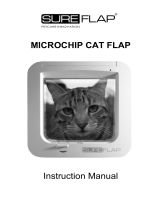 Sure Flap MICROCHIP CAT FLAP User manual
Sure Flap MICROCHIP CAT FLAP User manual
-
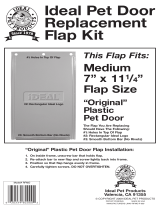 Ideal Pet RFMO Installation guide
Ideal Pet RFMO Installation guide
-
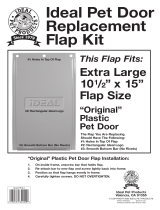 Ideal Pet RFXLO Installation guide
Ideal Pet RFXLO Installation guide
-
Petsafe PPA11-10709 User manual
-
Ideal Pet Products RWSLWK FAQ
-
Myfox TA4010 User manual
-
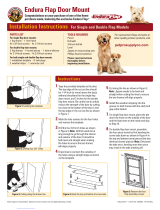 Patio Pacific Endura Flap Installation guide
Patio Pacific Endura Flap Installation guide
-
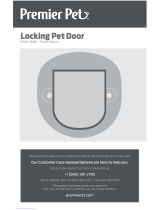 Premier Pet GPA00-16366 User manual
Premier Pet GPA00-16366 User manual
-
Petsafe PPA11-10709 User guide

































